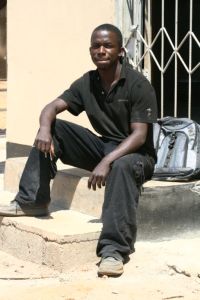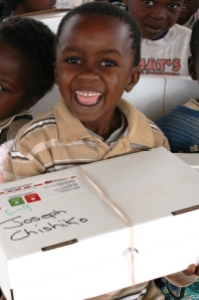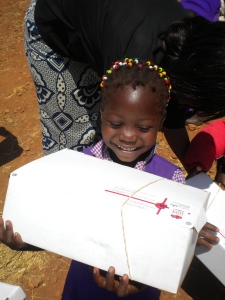This post is an article written by Lauren Bersaglio and it focuses on the Boxes of Love project and the impact it has on the children of Villages of Hope. We would like to thank all who have been involved in Boxes of Love – this is dedicated to you!
***
From One Hand to Another – the Journey of a Christmas Box
Julia and Kevin pack their three kids into the car and head over to Dollar Max. This is the tenth year in a row that they have made this trip to the store to find gifts to place in the white shoe boxes that were left in a pile at home. “We have always done a box,” says Julia, “and the number of boxes we filled increased as we had more kids.”
Do they bring their kids along every year?
“Definitely – they go to the stores with us and pick everything out; they love being a part of the process.”
Boxes of Love is a Christmas box project that was started up by Christian Life Assembly Church in Langley in 2001, and taking part in this project is an important tradition for the Eckert family. “It’s difficult to imagine a reality of a child that has never had a gift,” says Julia. “Boxes of Love gives us the opportunity to reach out and offer these children that chance. We’ve always had a passion for Africa and this is a way for us to reach out and help from a distance.”
Another reason the Eckert family takes part in Boxes of Love is to connect with their sponsor child. Boxes of Love now allows sponsors to fill out boxes labelled specifically for the kid(s) that they sponsor to allow for an even more personalized experience for both the sender and the receiver.
And having a personal feel is the very essence of what those who started Boxes of Love envisioned for this endeavor.
Behind the Scenes
Each year, more churches participate in the project. This year, not only did all four Christian Life Assembly locations participate, so did Living Waters Church in Fort Langley, Port Coquitlam Christian Assembly, Highway Christian Fellowship in Sidney, and Emmanuel Church in West Kelowna.
The number of boxes sent also increases each year. Last year, nearly 2,000 boxes were sent out, and this year saw even more boxes go to the children of Zambia.
These boxes are packed by members of the church and local community. Those who wish to be involved, go and pick up their empty boxes and then fill the boxes with various gift items. They then return the filled boxes to any participating church location.
Volunteers sort through each box to ensure they meet the content guidelines.
The boxes are then shipped on a container to Villages of Hope – Zambia. The container usually arrives in mid to late April, at which point they are distributed to all three Village of Hope – Zambia locations (Chongwe, Kitwe, and Mongu) and then handed out to the children from those communities.
“It has been incredible to be there to see the impact on the kids,” says Steve Nicholson, missions pastor at Christian Life Assembly’s Langley Campus, “especially those who have never received a gift before. There is joy, disbelief, excitement, singing, dancing – and utter amazement that Canadians would send them their own personal gift.”
Zambia’s Condition
According to UNICEF’s 2008 “State of the World’s Children” Report, only 30 per cent of vulnerable children where Villages of Hope is active have “basic material goods” – simply a blanket, a pair of shoes and a change of clothes.
Add that to UNICEF’s prediction of 64 percent of Zambia’s population living below the international poverty line (earning less than US$1.25 per day) and it isn’t hard to believe that these boxes may be the only gifts these children receive.
Villages of Hope – Africa works to assist those living in this poverty bracket.
Founded in 1999 under the Pentecostal Assemblies of Canada as a single orphan home in Kitwe, Zambia, Villages of Hope – Africa now has seven locations. They are located in Bujumbura (Burundi), Kisumu (Kenya), Lilongwe (Malawi), Kitwe, Mongu and Chongwe (Zambia), and Harare (Zimbabwe).
In total, Villages of Hope – Africa cares for approximately 2,200 vulnerable children, and nearly half of these come from the various locations in Zambia where the Boxes of Love are delivered.
Villages of Hope works in the form of residential housing for orphaned children. In addition, VOH provides free education to children from the surrounding communities all of whom benefit from VOH’s feeding programs, on-site clinics, and other facilities, which vary from village to village.
The first Village of Hope, located in Kitwe, Zambia, also has a Youth training program for the resident children who graduate from grade twelve and need assistance in acquiring skills that will help them become “independent contributing members of society” – which is the mission of VOH. The vision of Villages of Hope is “that all children are loved and cared for.” And Boxes of Love contributes to this effort greatly.
Packing the Boxes
So what do you send to a child who may not receive any other present this Christmas?
“I’m a good girl, so I go by the list,” says Julia.
And there is a list. Boxes of Love provides detailed information regarding what is (and is not) appropriate to be put in these Christmas boxes.
Recommendations include “basic need” items such as tooth brushes and Toothpaste, soap (unscented), shampoo, and school supplies and ‘fun extras’ such as puzzles, sunglasses, colouring and crossword books, underwear (unused), shoes, and candy.
Things that will not be sent are any items that may spill or melt and ruin the box, such as chocolate bars, glue, and bubbles; war items including toy guns, knives and camouflage apparel; anything containing batteries, as they may leak acid, and any used clothing or shoes.
Money also is not accepted – apart from the required $5 donation to help with the shipping costs of each box.
Boxes are divided by gender and age group – 3-5 years, 6-10 years, 11-14 years, and 15-18 years. This way, Boxes of Love can ensure that items in the boxes are age-appropriate.
Though Julia recalls from her recent trip to Village of Hope – Kitwe that age-appropriateness may not be what we would assume.
When Julia was there with a women’s team from CLA, they had hoped to help hand out the Boxes of Love, but the container was delayed at customs. Instead, they asked if any of the resident children wanted to bring by their favourite items from their boxes the year before and talk about them.
To Julia’s surprise, the children still had the white boxes and some of the things inside remained unopened.
“They had used their crayons one at a time,” Julia says, “and some things were still in packaging. How do you teach a nine or ten year old to cherish and value rather than hoard? To see dirty old boxes treasured like that – it was unbelievable.”
And she noticed how some of the boys and girls were treasuring items that we may consider ‘too young’ for someone their age; but the children didn’t seem to notice.
“The gifts don’t have to be age-specific,” she says, “because these boys and girls lost their childhood and this is their chance at getting it back.”
And “lost their childhood” is indeed one of the best ways of putting it.
Most of the resident children at Village of Hope are not only double orphans (having lost both their mother and father) but also do not have any other living relatives able to care for them. Their childhood was spent being passed around from relative to relative until there was no one left to care for them, at which point they ended up at Village of Hope.
Meet Nelson
Nelson Lubasi was one of these children.

Both of Nelson’s parents passed away when he was young and he eventually found himself with no one to look after him. In the year 2000, when he was only ten years old, he was found homeless – living on the street outside of the post office in downtown Kitwe – by a woman who worked in the area.
This woman knew of Village of Hope and contacted them to see if there was room for him to move into one of the resident homes. Fortunately, Village of Hope did have room and the woman brought Nelson to the site.
Nelson then moved into one of the residential homes and began attending the on-site community school.
As one of the Village of Hope children, Nelson was on the receiving end of Boxes of Love and he remembers his experience vividly.
“When we heard that the container with the Boxes of Love would soon be coming we got really excited,” Nelson says. “It usually arrived early in the morning and we knew what the honking of the horn sounded like at the gate. So we would listen for it each day and when we heard it, me and my friends would go running to the gate and then follow the truck to where it would park while the Boxes of Love were being unloaded. Everyone at Village of Hope always felt so happy the day that the container arrived and me and my friends always asked if we could miss school to help unload the big boxes from the container.”
“I used to sometimes wonder what made people decide to pack the Boxes of Love for us,” Nelson says. “I felt thankful that they did and I hoped that they would never stop.”
When asked what he would say to those who send the boxes, Nelson replied, “I would want to thank them and tell them ‘What you are doing is great…you are sowing seeds and you are a blessing, but you will also be blessed because of what you do.”
Ten years later, Nelson still remembers his first box.
“My favorite box was also my first box,” he says. “It had a brand new pair of NBA sneakers inside. I used to play basketball all the time, but didn’t have proper shoes to play in. When I wasn’t wearing my sneakers I would hide them under my bed; I only wore them to play basketball and to go to church. I wanted them to last as long as possible!”
Nelson lists off the other items he received in that first box – a math set, toy cars, candy, tooth paste, and pens – proving just how valuable each item in every box is to those who receive them.
Now that Nelson has graduated from grade twelve and the VOH Youth Program, he works as a driver at Village of Hope – Chongwe.
One of his current jobs is to transport the Boxes of Love from the Kitwe site to the Chongwe site (a four-hour drive). Now Nelson gets to stand on the other side and rather than being a receiver of the boxes, he gets to watch the responses of the children as he passes them out.
“I remember the first year that I gave out boxes,” he says. “It was also the first year that the children at Village of Hope – Chongwe received a box, so it was a first for all of us. It was a different feeling for me because now I had to be one of the ones helping to keep order and couldn’t be one of the excited ones. I felt really anxious for them because I knew how excited they were and that they didn’t really know what to expect. I remember saying to the other people handing out the boxes, ‘I know exactly how they are feeling right now.’”
In a final reflection, Nelson adds, “[Boxes of Love] made me feel that there was somebody who really cared for me and was concerned over my life and wanted to be sure that I was smiling.”
Giving out the Boxes
And it was these very smiles that stood out in Kevin Eckert’s mind when he recalled his trip to Village of Hope – Kitwe in 2009 when he had the opportunity to take part in the distribution of the boxes.
“Black face, white teeth – that’s the picture I keep seeing,” Kevin says, “full smiles.”
“And that’s big,” Julia adds, “because they don’t naturally smile – then to see that change when handing out the boxes, it’s pure joy and excitement.”
Nelson comments on the joy as well. “On the day that we were all given a Box of Love, nobody looked unhappy. Even some of my friends that often seemed sad and troubled were always happy and without worries on that day.”
“I didn’t expect the kids to be so thankful,” Kevin says. “You think about it…but then you are so blown away by how excited they are. It’s like their Christmas.”
And Christmas spirit really is the best way to describe it. “I used to like to wait to open my box and first watch what my friends were getting in their boxes,” Nelson says, “because that was also fun. We liked to see what each other was getting and we would share the sweets and sometimes play with each other’s things.”
“They have nothing, but they give out of that,” Julia comments in response to how the children share the contents of their boxes with each other. “It always amazes me how they give to each other out of their nothing.”
“I think I was more impacted than I thought I would be,” Kevin says when asked if his expectations met up with reality when handing out the Boxes of Love; “I was blown away. Kids there are so different than kids here,” he adds, “they were so patient as they waited for over an hour while we distributed the boxes and set everything up for pictures.”
Kevin recalls watching the children as they patiently waited with their boxes in their laps – not allowed to open them until everyone had been handed a box.
“We literally walked to each kid and handed them a box…and handing each box out individually to each kid and seeing their smiles – it wasn’t fake, it was totally real.”
Once all the kids have their boxes, they have to wait again while pictures are taken, which are sent back to the churches involved to allow those who were involved in packing the boxes a chance to feel, if only in part, what Kevin got to experience in person.
As per tradition, the kids then hold the boxes high in the air above their heads for a final photo and then put them back in their laps and drum on them with their hands.
One of the staff members then counts down until the glorious moment when they are told “Open!”
And then the excitement breaks out.
Once the word “Open” is said, the patience evaporates.
Just like Christmas morning, the kids sift through their boxes with urgency, holding up things to show their friends, putting on hats and sunglasses, and shoving candies into their mouths.
Within no time, soccer balls are inflated and are being kicked around the field while girls hug tightly to their dolls and young boys use their box as a ‘road’ for their new toy cars.
It’s something you’d expect of Whoville when the Grinch returned the presents.
“It’s true joy, real happiness,” Kevin says.
Disappointment
As with most things in life, however, nothing is perfect. And Kevin does recall one disappointment with his experience handing out Boxes of Love.
He remembers thirty to forty boxes that were obviously sent by a corporation, as each box was identical and contained branded socks and t-shirts (the company’s brand, of course), and they stuck out from the rest.
Some boxes simply don’t contain the same T.L.C. as others do.
“I remember one kid who got a hat and a t-shirt and nothing else and he just wasn’t as excited as everyone else who was running around and playing with their new toys and sharing candy.”
Those in charge of the Boxes of Love have fixed this problem, however.
When the men’s team that Kevin was on returned to Langley, they told the people in charge about these boxes that seemed somewhat inadequate. Now, CLA purchases a stock of ‘filler items’ – candy, colouring books etc… – and as the Boxes of Love volunteers sort through the boxes before shipment (removing any forbidden contents, which do sometimes make their way into the boxes despite the efforts to inform against them) they ‘bulk out’ any boxes that seem to be lacking with these filler items.
The end result ensures that each child will receive a box of the same quality that his or her friends receive.
Volunteers
Volunteers are essential to keeping the Boxes of Love project alive. And they are needed to do more than just fill out boxes and remove toy guns.
Those who help out aid in the acquiring of the new boxes each year and delivering them to the various church locations involved.
This year at CLA, white boxes were stacked one on top of the other, lining the walls of the front lobby and hallways. Each box contained a large sticker that said “LOVE” and a label that read: “Handle with care – this box is filled with love.”
Volunteers also collect the boxes when they are brought back full and put them in storage until sorting day.
On sorting day, if you walk into the gym at CLA, one will find organized chaos as volunteers sort through each box, adding filler candy, removing chocolate bars, and ensuring all the boxes are closed and the lids are held in place by rubber bands – it’s like Santa’s workshop – minus the elves.
It is a community of people dedicating their time to ensure that each child receiving a box feels loved.
Community
Among the boxes being sorted are those that were filled by Langley’s Mayor Peter Fassbender, who packs Boxes of Love every year.

When asked why he chooses to take part in the Boxes of Love each year, Mayor Fassbender replied, “The Boxes of Love are a very tangible way for those children who are living in circumstances beyond their personal control to know that there are people who care for them without any qualification. It is an amazing experience to see the faces of these children light up when they open their boxes. It also has a very profound effect on the teachers and parents/caregivers of these children to know that this is being done with no other motive than to bless these kids. It truly shows unconditional love and support.”
And the Mayor hopes that others will get involved as well.
“I would encourage everyone to get involved for two very specific reasons,” he says. “Firstly, it is a very tangible way to make a positive impact on the lives of children and those around them. Very often in communities we talk a lot about helping others but don’t always know how or what to do. Something like Boxes of Love are a simple, organized way to mobilize a number of people to do something that will have a significant positive impact. The second reason is very simple; it is amazing how good you personally feel when you do something for someone less fortunate than yourself. The old adage that it is better to give than receive definitely applies to the Boxes of Love!”
In fact, the Mayor believes it is important for the community of Langley to take part in any charitable endeavours.
“I have always encouraged our community to get involved in a variety of charitable causes,” he says. “It helps to reinforce our community spirit and it also reinforces the message that we live in a community with a heart. We are fortunate here in Langley to have been a community that steps up to the plate time after time. We have a heart of voluntarism and a caring attitude; this is what makes us a place where people feel at home and that there are people who care and look out for each other. This does not mean we don’t have challenges, but if people help each other it creates an environment where we can overcome any negatives we may face. I often say our community has a big heart and as such it is alive and well, no matter what may come.”
When asked if they would recommend others get involved in Boxes of Love, Julia and Kevin respond simultaneously: “Yes! Definitely.”
“Because it is truly impacting on kids,” Kevin says.
Julia adds, “As parents, it’s a great way to teach your kids about other cultures and how to impact others in a tangible way and how to touch someone else’s life. And that’s just doing the boxes – going there is a whole other thing – it changes something inside of you.”
Julia and Kevin want desperately to show their kids Africa and to give them the opportunity to share in this experience, but they want to wait until their kids are a bit older.
“We want them to be able to remember it,” Julia says and then laughs at the thought of trying to get her three young kids organized and onto a plane headed for Africa. “But one day we will.”
Impact

According to Georgy Zyambo, Principal at the Village of Hope – Kitwe Community School, not only do the Boxes of Love offer a day of joy and excitement to the children of Villages of Hope, but they also have a lasting impact on these children and the local communities.
“Students are excited and very happy on the day that we pass out the Boxes of Love,” says George. “The Boxes are like nothing else that they receive in the year; they are a rare gift that makes them feel blessed, loved and cared for. I have noticed that receiving the boxes causes them to be even more academically motivated – I think because that is their way of showing their appreciation. Sending a box of love home with each of the students enhances good relationships between Village of Hope and the surrounding community and helps develop a sense of mutual support and appreciation.”
Kevin struggles when asked to describe the emotions he witnessed in the Village of Hope children while opening their boxes.
“True joy. Real happiness – I don’t know how to describe it – gratitude. Appreciation.”
He pauses.
“It was just true. Real. Raw Love.”


